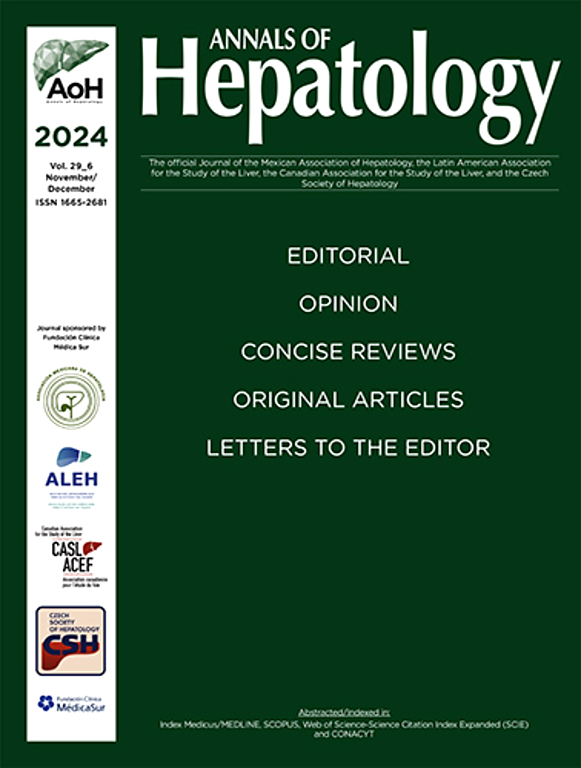康瑞珠单抗联合经导管动脉化疗栓塞术、索拉非尼或来伐替尼治疗不可切除肝细胞癌: 一项多中心回顾性研究。
IF 3.7
3区 医学
Q2 GASTROENTEROLOGY & HEPATOLOGY
引用次数: 0
摘要
简介和目的:我们发起了这项研究,以探讨康瑞珠单抗联合经导管动脉化疗栓塞(TACE)加索拉非尼或来伐替尼与TACE加索拉非尼或来伐替尼治疗不可切除肝细胞癌(HCC)的疗效:本研究对2019年6月至2022年11月的127例晚期HCC患者进行了回顾性分析。其中包括44例接受康瑞珠单抗+TACE+索拉非尼或来伐替尼治疗的患者(三联治疗组)和83例接受TACE+索拉非尼或来伐替尼治疗的患者(双联治疗组)。比较了两组患者的总生存期(OS)、无进展生存期(PFS)、客观反应率(ORR)和疾病控制率(DCR):结果:我们的研究结果表明,接受三联疗法的患者的中位OS(15.8个月 vs. 10.3个月,P=0.0011)和中位PFS(7.2个月 vs. 5.2个月,P=0.019)均优于双联疗法组。此外,三联疗法组的 6 个月生存率(93.5% 对 66.3%)、12 个月生存率(67.2% 对 36.3%)和 24 个月生存率(17.2% 对 7.6%)均优于双联疗法组。不过,两组的ORR(43.2% vs. 28.9%,P = 0.106)和DCR(93.2% vs. 81.9%,P = 0.084)相似。亚组分析显示,与双重治疗组相比,三联治疗组对伴有HBV的HCC(15.8个月 vs. 9.6个月,P = 0.0015)和肿瘤直径≥5cm的HCC(15.3个月 vs. 9.6个月,P = 0.00055)的mOS更好:结论:卡瑞珠单抗联合TACE、索拉非尼或来伐替尼可能是临床治疗不可切除的HCC患者的一种很有前景的治疗方法。本文章由计算机程序翻译,如有差异,请以英文原文为准。
Camrelizumab combined with transcatheter arterial chemoembolization and sorafenib or lenvatinib for unresectable hepatocellular carcinoma: A multicenter, retrospective study
Introduction and Objectives
We initiated this study to explore the efficacy of camrelizumab combined with transcatheter arterial chemoembolization (TACE) plus sorafenib or lenvatinib versus TACE plus sorafenib or Lenvatinib for unresectable hepatocellular carcinoma (HCC).
Materials and Methods
From June 2019 to November 2022, 127 advanced HCC patients were retrospectively analyzed in this study. This consisted of 44 patients that received camrelizumab plus TACE plus sorafenib or lenvatinib (triple therapy group) and 83 patients that received TACE plus sorafenib or lenvatinib (double treatment group). The overall survival (OS), progression-free survival (PFS), objective response rate (ORR), and disease control rate (DCR) were compared between the two patient groups.
Results
Our findings demonstrated that patients received the triple therapy exhibited superior median OS (15.8 vs. 10.3 months, P=0.0011) and median PFS (7.2 vs. 5.2 months, P=0.019) compared to the double treatment group. In addition, the triple therapy group exhibited better 6-month (93.5% vs. 66.3%), 12-month (67.2% vs. 36.3%), and 24-month (17.2% vs. 7.6%) survival rates than the double treatment group. However, the ORR (43.2% vs. 28.9%, P = 0.106) and DCR (93.2% vs. 81.9%, P = 0.084) of the two groups were similar. Subgroup analysis showed that compared with the double treatment group, the triple therapy group had a better mOS for HCC with HBV (15.8 vs. 9.6 months, P = 0.0015) and tumor diameter ≥ 5cm (15.3 vs. 9.6 months, P = 0.00055).
Conclusions
Camrelizumab plus TACE and sorafenib or lenvatinib may be a promising treatment approach for the clinical management of unresectable HCC patients.
求助全文
通过发布文献求助,成功后即可免费获取论文全文。
去求助
来源期刊

Annals of hepatology
医学-胃肠肝病学
CiteScore
7.90
自引率
2.60%
发文量
183
审稿时长
4-8 weeks
期刊介绍:
Annals of Hepatology publishes original research on the biology and diseases of the liver in both humans and experimental models. Contributions may be submitted as regular articles. The journal also publishes concise reviews of both basic and clinical topics.
 求助内容:
求助内容: 应助结果提醒方式:
应助结果提醒方式:


